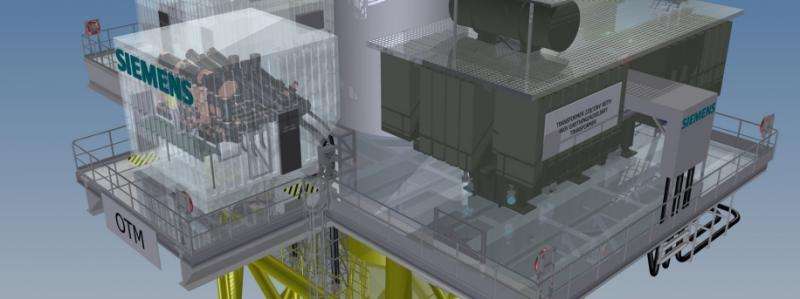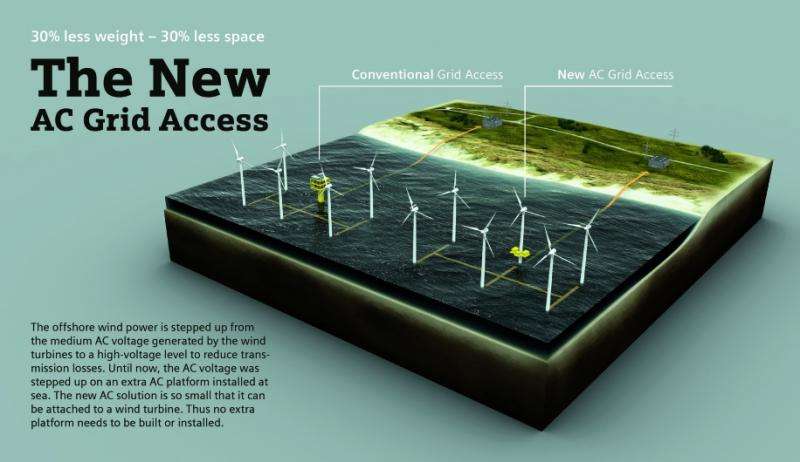New module lowers the cost of offshore wind power

A new AC power connection module for near-shore wind turbines is expected to cut the cost of accessing the grid for such installations by as much as 40 percent. This solution from Siemens thus also reduces the cost of energy from offshore wind farms. In contrast to conventional AC transformer platforms, the new module can be mounted directly on the foundation of an existing wind turbine thanks to its small and lightweight dimensions, thereby minimizing materials, time expenditures and risk. A biodegradable insulating fluid also makes this decentralized solution extremely environmentally friendly. Siemens recently presented it at the EWEA offshore conference in Copenhagen.
Transformer substations are a core part of wind farms. They are critical for transmitting the electricity generated from wind turbines to the mainland at higher voltages via subsea cables, which results in lower energy losses. Previous solutions were always built on an additional platform structure and due to their size & enormous weight (1,800 to 4,000 metric tons), added tens of millions Euros, and in some cases hundreds of millions Euros, to project costs.
Cost reduction
The new offshore transformer module (OTM) can be installed with various manufacturers' turbines, either on a dedicated foundation or, to maximize savings, on an existing turbine foundation with both the wind turbine and OTM attached. This is possible thanks to the module's light weight and small dimensions of approximately 30 by 15 meters. A large portion of grid access costs for near-off-shore wind facilities goes to building, transporting, assembling, operating and maintaining the platform. The new solution from the Siemens Energy Management Division will thus help reduce these costs by as much as 40 percent.
The new substation, which dispenses with some auxiliary systems, has been reduced to its essential electrical components. This has made it possible to reduce its total weight to around 630 metric tons for a module with an output of 250 megawatts. In order to reach the transmission capacity required in very large wind farms, multiple modules can be connected to each other. Other costs were reduced in the areas of transport and installation, since a special heavy-load crane vessel is no longer necessary. In addition, the time it takes to assemble an OTM has been shortened by 20 percent, since conventional and more readily available installation ships, known as Service Operation Vessels, can now be used. Maintenance has also been reduced, since fans and diesel generators are no longer required.
A biodegradable transformer insulation medium

Instead of mineral oil, the new connection solution uses a non-toxic, ester-based insulating fluid – a biodegradable and low-flammability transformer insulation medium. This is an important requirement for use in the open ocean and for maintaining environmental standards.
Siemens is conducting negotiations regarding the use of its new technology in several offshore projects. The new offshore transformer module is a crucial lever for reducing the cost of electricity generated from offshore wind energy to ten euro cents per kilowatt hour by 2020, a goal Siemens has announced. Thanks to the knowledge gained from more than ten AC power projects, conventional platform systems are also being optimized. Siemens offers a high degree of flexibility and an extensive selection of systems for the cost-efficient expansion of renewable energy.
Provided by Siemens





















